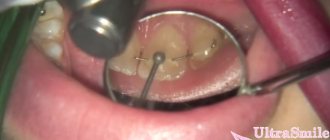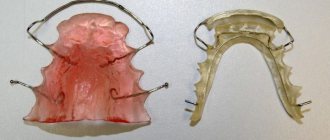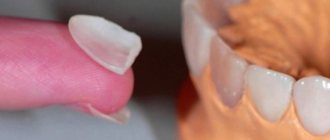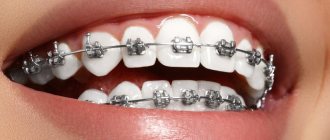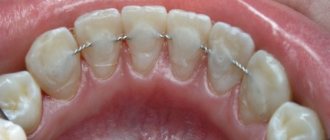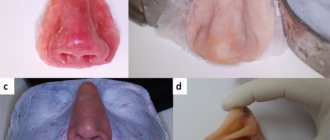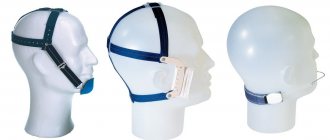In correcting dental malocclusion, the retention stage is very important. It is necessary in order to consolidate the results achieved by wearing braces. While wearing braces, teeth move under pressure. In this case, old tissues are torn and new ones are formed. Once the braces are removed there is no more pressure. There is a risk that the teeth will return to their original position.
Retainers help avoid this situation. They help teeth secure themselves in their new position. As a rule, the retention period lasts 2 times longer than treatment with braces. But the exact period is determined by the doctor depending on the complexity of the clinical case.
Retainers on the jaw
A retainer is a removable or non-removable special device made of acrylic material or wire, fixed on the inside of the teeth, designed to prevent relapses, which may be caused by the growth of bones, alveolar processes, displacement of rows, and bad habits.
Requirements for retainers
:
- reliable fixation of organs in a new position;
- minimal impact on phonetics, articulation, aesthetics;
- possibility of changing the wearing mode (dosed/round-the-clock);
- minimal restriction on unit mobility;
- a dental retainer should not provoke caries or inflammatory reactions;
- the material used must have good resistance to bacterial attack.
Adaptation occurs in a short time: the device does not cause discomfort, is invisible in the oral cavity, does not spoil the appearance, and does not interfere with chewing functions.
Indications
Finishing correctors are used to prevent relapse of tooth displacement and consolidate the results obtained during orthodontic treatment. The period of wearing the structures is approximately twice as long as the time spent on the main treatment.
The installation of a corrector is contraindicated if the patient is allergic to the components from which the product is made. It is prohibited to install mouthguards on units affected by caries. Oral hygiene becomes difficult and the condition of teeth deteriorates.
Installation
Before attaching the correction device, preliminary preparation is required. The braces system is removed and the sharp edges of the teeth are polished, tartar and plaque are removed, and caries is filled. If the enamel becomes thinner while wearing braces, the dentist decides on the need for fluoridation and mineralization.
Then the doctor begins the process of fixing the non-removable structure:
- A dental compound is applied to the teeth to protect the enamel and increase its adhesion to the composite.
- The arc is attached to the surface of the units with a filling compound.
- Excess composite is removed. Grinding in progress.
The structure is fixed by an orthodontist. Successfully completing the retention period will not be difficult for a person who has undergone treatment with braces.
Patients must strictly adhere to medical recommendations. If the arch comes loose or the device is damaged, immediate dental consultation is required.
Care
Without careful oral hygiene, there is a risk of bacteria accumulation, tooth decay and plaque. A non-removable metal retainer does not require special care. It is enough to follow simple recommendations:
- Gently brush your teeth every day with a brush and toothpaste.
- Use of dental brushes, dental floss and irrigator.
- Regular dental visits for professional cleanings.
- If the structure breaks down, a visit to the doctor is required for repair and correction. Otherwise, the units will shift.
It is not recommended to put intense stress on your teeth: cracking nuts, opening lids. The result will be damage to the tooth enamel and breakage of the mouth guard.
Timing and cost
The procedure for attaching a mouth guard takes up to 30 minutes. The duration of the retention period is twice as long as the systems are worn. Patients who have undergone bite correction after age 25 are recommended to wear mouth guards throughout their lives.
The length of time you need to wear the mouth guard varies from person to person and is determined by a number of factors:
- The age of the patient. In adolescents, restructuring of the ligamentous apparatus and muscles occurs at an accelerated rate. At this age, pads are worn from six months to two years.
- Bad habits. People who smoke have a reduced immune response and poor blood flow. The correction process takes longer for them.
- Condition of the oral cavity. Fixation of the ligaments is completed faster with healthy teeth and periodontal tissues.
- Complexity of the clinical situation. If the curvature is severe, a longer correction is required.
Retention should be carried out under constant medical supervision. Do not neglect consultations with your dentist and remove the devices yourself.
The price of fixed retainers is determined by the complexity of the clinical case. Installing the structure on one jaw will cost approximately 4,100 rubles.
Fixed
It is used in case of predictable instability of the row, with planned long-term retention. It is a structure assembled from rings/crowns that limit the working area and a tangential wire secured with filling material.
Indications
:
- patient indiscipline;
- stabilization of the position of the lower incisors;
- control of diastema closure.
Fixed systems are demanding in terms of hygiene, but give excellent results, since the teeth are in a fixed position during the treatment process.
Disadvantages and advantages:
- no discomfort during installation and subsequent operation;
- constant impact on the tooth, which increases the effectiveness of treatment;
- there are no visual signs of the product being in the mouth;
- quick adaptation to the device.
The disadvantage of a non-removable dental retainer is the need to visit the dentist and periodic damage to the wire.
Fixed systems
Fixed retainers are used after the treatment of complex malocclusions. They are installed in a dental office. The orthodontist uses a special glue to fix a metal wire on the inner surface of the teeth. This design is completely invisible and does not cause discomfort while wearing.
While wearing fixed structures, the patient must follow several rules:
- Ensure normal oral hygiene. Teeth with a permanent retainer are cared for in the same way as with braces, so patients do not experience any difficulties.
- Have it professionally cleaned twice a year. The retainer interferes with normal hygiene, so cleaning by a hygienist is mandatory.
- Visit your orthodontist twice a year for an examination. He evaluates the result of retention, checks the quality of fixation of the structure, and secures it if necessary.
Visits to the orthodontist cannot be neglected. After bite correction, teeth tend to return to their original position. If the retainer comes loose, it will happen in about 4 days. The entire treatment result will be lost.
Another type of modern non-removable structures are interconnected lumineers. The advantage of this method is high aesthetics. The smile looks even and beautiful, while lumineers reliably hold the teeth in the desired position and prevent them from moving. When the retention period is over, the structure can be disconnected. In this case, the lumineers remain on the teeth. This method differs from wire retainers in its higher cost, but if the aesthetics of your smile is important to you, we recommend choosing it.
Removable
A system consisting of a plastic base (plate) with/without clasps and adjustment loops. Depending on the situation, additional elements are introduced into the design: vestibular arch, tongue barrier.
Indications
:
- stabilization of ranks in all segments;
- control of the position of the incisors;
- maintaining closed spaces after extraction of the first molars.
A removable retainer is easy to care for; it holds each unit firmly and does not require constant wearing.
Disadvantages and advantages:
- can be worn for several hours a day (regularity/timing is determined by the doctor);
- easy to clean with paste and brush;
- allows you to take a break from the presence of structures in the oral cavity after treatment with braces.
Among the disadvantages of installing a removable system: unaesthetic appearance, ineffectiveness in maintaining the result of correcting an incorrect deep bite, can provoke allergies, irritation of the mucous membrane, and impaired diction.
Removable systems
There are two types of removable systems – plates and mouth guards. They differ in their design. The plate is a plastic structure with a metal bracket. They are worn only during the day. The plate must be removed when eating. Plates are well suited for retention after correction of complex malocclusions.
Mouthguards are made from different materials - plastic, silicone, gels with a film or fibrous structure. The most physiological ones are thermoplastic structures. Before installation, they are kept in hot water. In the mouth, the mouthguard cools down, shrinks and presses tightly against the surface of the teeth, perfectly following their shape.
Unlike plates, they are soft and transparent, almost invisible in the mouth. At first, the mouth guard is worn daily. Once the result of the correction is established, you can wear it several times a week.
The simplest and cheapest option is standard pharmacy mouth guards. They differ in size, but it is impossible to adjust such designs to individual characteristics. You may feel uncomfortable while wearing it. Individual mouthguards are made from impressions. They are more expensive, but completely replicate the anatomical features of the patient.
Dentistry for those who love to smile
+7
Make an appointment
Orthodontic splint
Used for positional retention of teeth. After removing the braces, the dentist takes impressions from which a model of the mouth guard is made. The splint should be worn for several years, putting it on every night.
In most cases, the device is worn on the upper jaw, since the lower units change their position over 2-3 years, forming a functional closure.
Types of caps:
- standard. Mass-produced products can be used immediately after purchase. Disadvantages: they do not take into account the anatomy of the row structure, therefore they are not suitable for all patients;
- thermoplastic. They are mass-produced and are distinguished by their ability to adopt the natural structure of the series;
- individual. Effective, accurate, most comfortable, repeating all the positional features of the organs in the oral cavity.
How much does the design itself cost?
For the retention period, two types of retainers are used: removable and non-removable .
Removable structures are cheaper to maintain, as they do not require the involvement of a dentist or any special equipment for their installation and removal.
Fixed structures can only be installed, removed, or replaced in a dentist’s office, which affects the final cost of the service.
Fixed
Unlike removable retainers, the non-removable type has only a few models that resemble each other in appearance, but have different prices:
- Classic retainers. They are a metal arch that is fixed on the lingual (inner) side of the front teeth. Installation of this model will cost approximately 5 thousand rubles.
The reasonable cost is due to the simplicity of the device and ease of installation. To make an arc, casts are made, on the basis of which a working model is formed. Then a retention arch is twisted from many strands of thin wire.Fixation is carried out using a durable composite directly onto the enamel. For fastening strength, it is preferable to use glue designed for installing braces, which will slightly increase the cost.
- Ribbon tape. Its effect is similar to the classic version of a retainer. Only in this case, instead of a metal arc, a special fiber system made of highly aesthetic, durable material is used.
To produce this fiber, special equipment is required, which increases the price.In addition, installing Ribbon tape implies the need to prepare each tooth to form a longitudinal groove in it where the structure will be fixed.
Preparation will also be included in the total cost, which averages 10 thousand rubles .
Removable
At the moment, almost every dental clinic can offer a large number of different retainers, among which you can choose both classic-type models and completely non-standard samples.
The most popular designs are::
- Trainers – are a one-piece construction designed for putting on more than two jaws at once. It is used as a retention device only at night, during sleep.
The devices do not require the taking of impressions and the cost of procedures performed in a dental laboratory. They are made by the manufacturing company according to a standard template in several sizes from hypoallergenic elastic silicone.Each individual model is the same design, only of a different volume. Despite the fact that manufacturing a trainer is considered inexpensive, the cost of the product is still not small and is within the range of 4–6 thousand rubles .
This is explained by the demand for the product, since trainers are capable of not only maintaining the result of bite correction, but also completely eliminating myofunctional problems.
- Retention mouth guards - this is a more expensive design than the previous version, its average price is 10 thousand rubles. Manufacturing the design will add to the price list the cost of taking impressions, making a diagnostic model and the materials used.
The plastic model made from Bioplast is considered more economical; it is flexible and has low strength.Another model has a two-layer coating, which makes it more rigid and at the same time retains shock-absorbing properties, preventing injury to the tissues of the oral cavity. Such a device is a more expensive product, but it is also more durable.
- Retention plates – the most common option due to its availability. The cost of such a device starts from 4 thousand rubles. The device is intended for use on the upper jaw only.
The device consists of several main parts: an acrylic base, a retention arc and fixing elements. In this case, the cost will be influenced by the material used to make the arc and the method of fixing the plate.The lowest cost will be for an arc made of an alloy based on nickel and chromium. Also, the cost can be increased if clasps were installed on the plate as fixing elements.
In addition, it should be taken into account that structures are made only on an individual basis, with impressions taken and the involvement of a dental laboratory in the process.
- Covering retainers are the simplest option, consisting of a metal arch covered with a protective plastic layer.
The arch is bent in such a way as to form a frame for teeth that require strengthening. When installed, the frame covers both the vestibular and lingual surfaces. The cost of this design is equal to retention plates and averages 5 thousand rubles .
Causes of relapses
- excessive tilt of the frontal group units and overstrain of the oral muscles;
- left “eights”, which, when erupting, cause displacement of organs;
- expansion between “threes” - the more it increases, the more rapidly it contracts after correction, which is fraught with crowding;
- rotation of teeth (rotations around an axis);
- violation of the norm for maintaining the natural shape of the mandibular arch - retention devices only in 50-60% of cases repeat its configuration - it tends to return to its original position after 10-12 years;
- jaw growth. If the correction is completed in adolescence, with the vertical type of growth against the background of an open bite, a relapse is possible, and the horizontal type causes a deepening of the incisal overlap with age, therefore such anomalies require observation until the patient is 20 years of age;
- unresolved deviations in the articulation of the tongue when chewing food and swallowing;
- poor quality correction. With severe crowding, no space was created in the row, which led to the units tilting forward; after correction, a significant gap remained between the lower/upper incisors, which caused the upper teeth to return to their original position.
To prevent relapse, you must follow all recommendations, maintain discipline, and see an orthodontist once every six months. If displacement cannot be avoided, the dentist will suggest suitable re-treatment options.
Conditions for successful retention
:
- identifying the causes and factors that provoked the orthodontic defect. If they are not eliminated in time, there will be no lasting result - the teeth will become crooked again;
- competent correction. An inadequate therapeutic regimen or errors when correcting a bite with a brace system can cause unstable location;
- optimal design of the retention system.
Retainer installation
It is not intended to install a removable system; if necessary, the patient removes/puts it on independently. The fixed structure is attached after removing the brace system and sanitizing the oral cavity.
Installation is possible in two ways - indirect and direct. Direct implies installation without accompanying manipulations. Indirect takes place in several stages:
- taking and making impressions;
- making a product from a cast, giving it a jaw configuration;
- installation, polishing.
The cost of installing removable and non-removable retainers consists of many factors: prices for additional procedures (diagnosis, treatment, professional cleaning), method of fastening, type of system. The final price tag for the service varies between 5-20 thousand rubles.
Treatment with aligners
There are several types of retainers that are installed on teeth after braces. An orthodontist will help you choose the most suitable one. Devices can be classified by size and type of material, but the classic basis for dividing products into groups is the ability to independently remove the simulator. Thus, there are fixed and removable retainers. Each type has its own characteristics and advantages.
Fixed retainers
The device is a small fixing wire that is attached to the inside of the teeth. It is installed by the doctor immediately after the braces are removed.
There have been many studies on the effect of wire on teeth. The product is absolutely safe for enamel, it is attached with a special composite material and practically does not interfere with the patient.
Indications for wearing fixed structures:
- Patient indiscipline;
- Stabilization of the position of the lower incisors;
- Control of diastema closure.
Installing a retainer requires preliminary preparation. After all elements of the brace system are removed, the doctor grinds the uneven edges of the teeth, removes bacterial plaque and stone, and fills all carious cavities. And then only the wire is fixed on the incisors and canines.
On average, after the installation of retainers, a week must pass for the patient to stop noticing them. The only inconvenience he faces is the need for more thorough brushing of his teeth.
The wire is very thin and does not interfere with diction or chewing of food. The design is almost invisible. She practically does not impose restrictions on food - you just need to be more careful when biting off solid food. The filling material that holds it in place is carefully polished, making the back surface of the teeth perfectly smooth.
Many people choose non-removable models, because such a retainer is invisible and does not interfere with the smile. If you don't tell the person you're wearing a device, no one will know about it.
Removing the retainer to straighten the teeth also does not take much time - the orthodontist carefully separates the composite that secures the arch and grinds the teeth to remove any remaining material. The cost of making and attaching a permanent retainer is often included in the cost of orthodontic treatment. You can find out the exact price from your doctor.
| Advantages | Flaws |
|
|
Removable structures
A removable retainer is also called a “retention mouth guard.” Unlike removable systems, such systems require diligence and pedantry from the patient: it is necessary to strictly follow the doctor’s instructions, wear the products for the prescribed time, day and night. To consolidate the results of orthodontic treatment, two types of removable structures are used: plates and aligners.
Indications for the use of removable devices:
- Stabilization of ranks in all segments;
- Control of the position of the incisors;
- Maintaining closed spaces after extraction of first molars.
Mouth guards are usually made for both dentitions, made from hypoallergenic plastic according to an individual jaw cast. The material is absolutely invisible even from close range, so wearing it during the day at work or school will not cause any problems. The plate is also made from an impression: the plastic base follows the shape of the palate/gums, and the metal arches “hug” the teeth, fixing them.
Often, a removable retainer becomes an addition to a fixed model. Then it is worn overnight and removed for the day, but the wire remains on the teeth for 24 hours.
The cost of aligners and plates is almost an order of magnitude higher than that of a retainer. This is not surprising. They are made individually based on an impression of the patient's teeth. In some cases, an orthodontist, after removing braces, may recommend the use of both types of retainers: removable and non-removable.
There are two types of removable structures:
- Retention mouthguards.
Transparent, almost invisible on the teeth. Mouthguards are made from transparent elastic silicone. Thanks to this, the surface of the products has exactly the same shine as healthy tooth enamel, and does not reflect glare in the sun or when photographed with a flash. Mouthguards installed in the mouth cannot be seen even from close range. They don't interfere with talking and smiling. And they can be removed while eating and brushing your teeth. - Plates.
It has a transparent plastic base and metal elements that fix the position of the teeth. Elastic plastic with carefully polished edges is absolutely safe for mucous membranes; wire arches and loops prevent the movement of teeth. The obvious disadvantage of the plates is the ability to remove them and stop using them. It is enough to stop using platinum for just a couple of weeks so that the design made from an impression of the teeth immediately after the braces are removed will no longer fit.
There is no clear consensus regarding the installation of the most effective type of orthodontic appliance for retention. The choice of method depends on several factors: the patient’s financial capabilities, his age, the complexity of the malocclusion, and the anatomical features of the jaw structure. When used correctly, both options are acceptable and give good results.
| Benefits of retainers | Disadvantages of retainers |
|
|
Combined installation
Sometimes the patient is prescribed combined retainers - a permanent wire is fixed to one row of teeth on the inside of the teeth, and a retention mouthguard is recommended to be worn on the other. Or, first, fixed retainers are installed, and after a while they are removed and mouth guards are prescribed.
The duration of the retention period is always individual and depends on the patient’s age, malocclusion and other factors. The average period is two periods of wearing braces, and permanent structures can be installed for life. Removable ones are worn according to a schedule determined by the doctor: most often this is either only worn at night, or at night and for several hours during the day.
Wearing time
The optimal option is to fix the retainer on six frontal units, the simplified option is to fix it on four incisors, but in this case there is a risk of the canines returning to their original location.
To prevent the opening of the gap in the tooth extraction area, premolars are connected to the device:
- Products on the upper jaw should last 5-10 years. If, during correction, good closure in the lateral/anterior sections is achieved, treatment continued for 1.5-2 years, the retention period is reduced to 2-3 years;
- Duration of wearing on the lower one is at least 10-15 years. This is due to the instability of the incisors and their predisposition to relapse. .
Types of permanent retainers
Custom-made devices:
- made of steel wire with a diameter of 0.6 mm for wide use;
- wire or cast retainer with rings for supporting teeth (for the treatment of crowding of the front teeth on the canines);
- twisted structure made by hand twisting 3 ligatures with a diameter of 0.02 mm. Ideal for the upper jaw for a period from 6 months to 1.5 years.
Standard devices;
- Leone: device for the upper jaw with clasps for each tooth;
- Ormco: lingual appliance for the lower jaw with clasps for the canines;
- Ormco: twisted archwires from Triple Flex and Respend;
- Lancer: Splintax twisted wire.
Whatever type of design is preferred, fixing any permanent retainer requires mandatory manipulation.
What should you not do when wearing it?
Wearing a removable or fixed retainer requires compliance with rules similar to the use of braces. Forbidden:
- frequently consume hot drinks/meals, solid foods;
- smoking, chewing hard objects with teeth;
- leave the structure outside the case;
- store near heating devices, heating radiators;
- carry out independent repairs/removal of fixed restorations;
- change the wearing regimen prescribed by the orthodontist.
Care
When using the product, do not use a toothpick, floss, or whitening paste. A removable dental retainer should be thoroughly cleaned after eating, use an irrigator, and be sure to brush during hygiene activities. In the event of a breakdown, you must immediately contact your dentist to replace or glue an additional segment of the structure.
If a non-removable retainer breaks, a characteristic crunching sound occurs when eating, and the structural element can scratch the tongue. You cannot put off a visit to the doctor - teeth tend to change their position significantly even within a few days.
It is recommended to completely remove the device in case of irreversible damage to replace it with a new one at the end of the required wearing period.
Prices for installing retainers
Correcting the bite in this way has positive reviews from children and adults. To calculate the cost of retainers, sign up for a consultation at Dr. Razumenko’s dentistry in Moscow. To do this, fill out an application on the website or call.
| Code no. | Name of procedures | Unit of measurement | Cost, rub. |
| 901 | Initial oral consultation with a dentist - orthodontist | 2 500,00 | |
| 914 | Gluing a retainer (bracket) | 1 tooth | 850,00 |
| 964 | Joint splint Splint | 27 000,00 | |
| 965 | Retention tray transparent | 1 person | 6 000,00 |
| 966 | Mouthguard for the treatment of bruxism | 15 000,00 | |
| 967 | Sports mouthguard 5 layers | 20 000,00 | |
| 968 | Sports mouthguard for children | 10 000,00 | |
| 969 | Mouthguard 3X layer | 15 000,00 | |
| 976 | Small course (up to 14 aligners) made in the Invisalign laboratory | 220 000,00 | |
| 977 | Full course (from 14 aligners) made in the Invisalign laboratory | 280 000,00 |
* The prices indicated on the website are not a public offer. The exact cost of treatment can only be determined at an appointment with a doctor.
Prices for treatment in Moscow full price list
Share on social media networks:
Article Expert:
Oganesyan Diana Feliksovna
Dentist-orthodontist. He regularly improves his professional level and studies modern methods of orthodontic treatment at international seminars and conferences of outstanding orthodontists in the world. He is a member of the Italian Society of Orthodontists (SIDO) and the European Aligner Association (EAS).
Work experience over 6 years
We recommend that you read
Invisalign
Braces
Correction of bite with mouth guards
Damon braces
